#Rockefeller Institute
Link
#toxicology#virology#rockerfeller#rockefeller institute#polio#polio scam#glyphosphate#pesticides#DDT
3 notes
·
View notes
Text
This information is attributed to Carrel, and the copy of the article from the Rockefeller archive bears the comment 'false interview'.
"Frankenstein's Footsteps: Science, Genetics and Popular Culture" - Jon Turney
#book quote#frankenstein's footsteps#jon turney#nonfiction#alexis carrel#misattributed#article#rockefeller institute#false interview
0 notes
Link
The best lies money can buy
#toxicology#virology#DDT#Polio#Rockefeller Institute#fraud#deception#pseudoscience#vaccines#harms#injuries#cover-up#public relations
0 notes
Text
Here's Exactly How Cocaine Makes You Ignore Your Basic Needs
Scientists may have figured out how addictive drugs like cocaine hijack the brain’s reward system to make us ignore basic needs like food or water. In mice, the researchers were able to extensively detail a neural pathway that allows the brain to respond to natural positive stimuli, while also showing how drugs can interfere with this pathway for the worse. The findings not only illuminate a key…
View On WordPress
#addiction#Addiction-related structural neuroplasticity#Bowen Tan#Caleb Browne#centre for addiction and mental health#cocaine#dopamine#Epigenetics of cocaine addiction#Gizmodo#health#Howard Hughes Medical Institute#medical#Nucleus accumbens#Pharma#Reward system#Rheb#Substance dependence#Substance-related disorders#the rockefeller university
0 notes
Text
Universitas Rockefeller berperan bisnis menyebarkan virus dan menjual penawar virus
“ROCKEFELLER INSTITUTE”
“BISNIS VIRUS” menyebarkan virus dan menjual penawar virus.
THOMAS MILTON RIVERS adalah orang AmerikaBakteriologis dan Virologis. Dia dikenal sebagai”Bapak VIROLOGI” Pada tahun 1922, dia mengepalai bangsal penyakit menular di institute rockefeller.
Selengkapnya klik disini.

#Institute rockefeller memainkan peran mencuci otak massa#The Rockefeller University memainkan peran penting cuci otak#Universitas Rockefeller menyebarkan virus dan menjual penawar virus
0 notes
Link
0 notes
Text
~ Helen Keller ~
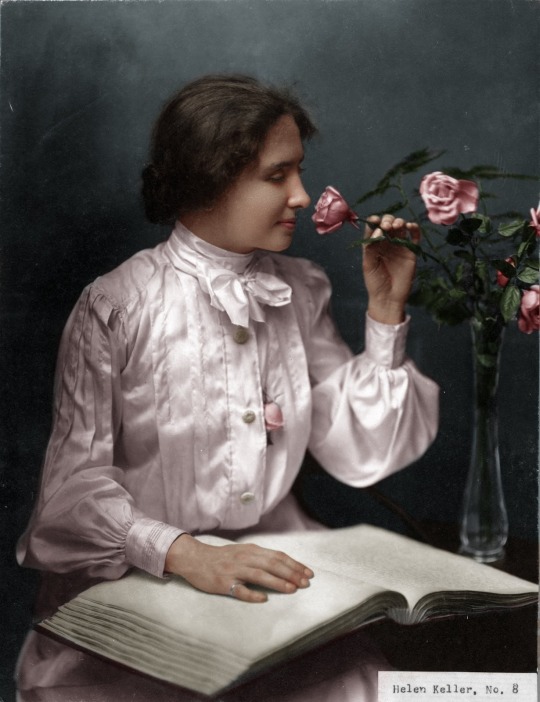
Helen Keller (colorized)
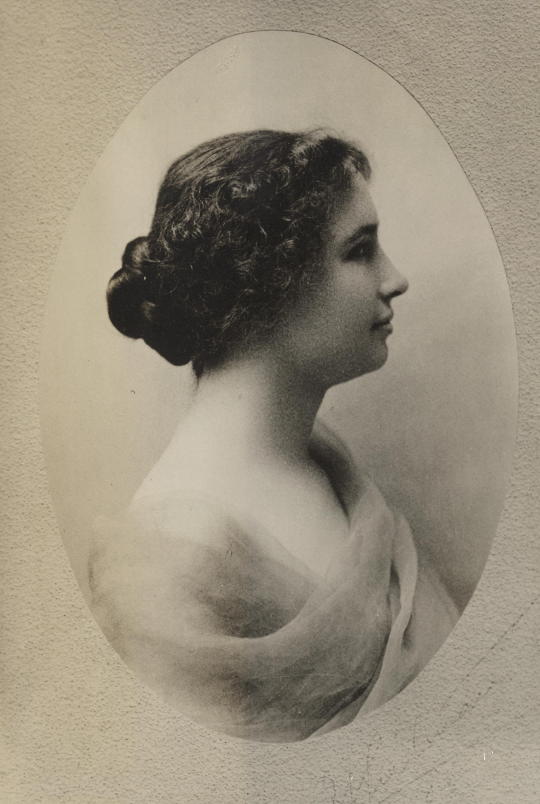
Miss Helen Keller - Portrait US Library of Congress
Helen Keller was an author, lecturer, suffragists and crusader for the handicapped. Born in Tuscumbia, Alabama, She lost her sight and hearing at the age of nineteen months to an illness now believed to have been scarlet fever. Five years later, on the advice of Alexander Graham Bell, her parents applied to the Perkins Institute for the Blind in Boston for a teacher, and from that school hired Anne Mansfield Sullivan.
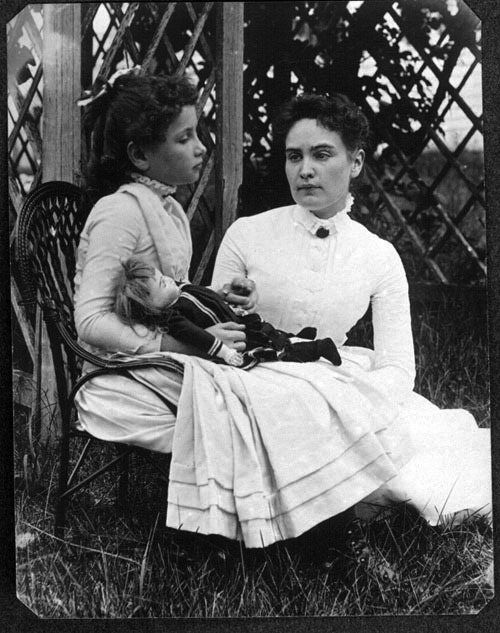
Keller (left) with Anne Sullivan vacationing on Cape Cod in July 1888
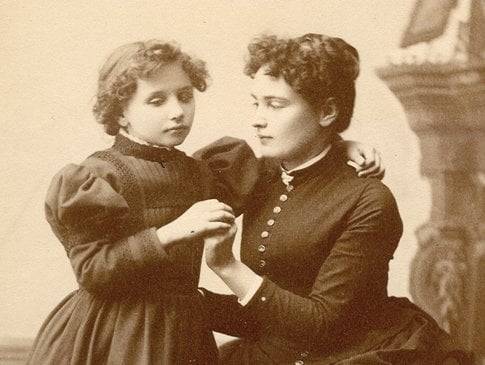
Through Sullivan’s extraordinary instruction, the little girl learned to understand and communicate with the world around her. She went on to acquire an excellent education and to become an important influence on the treatment of the blind and deaf.
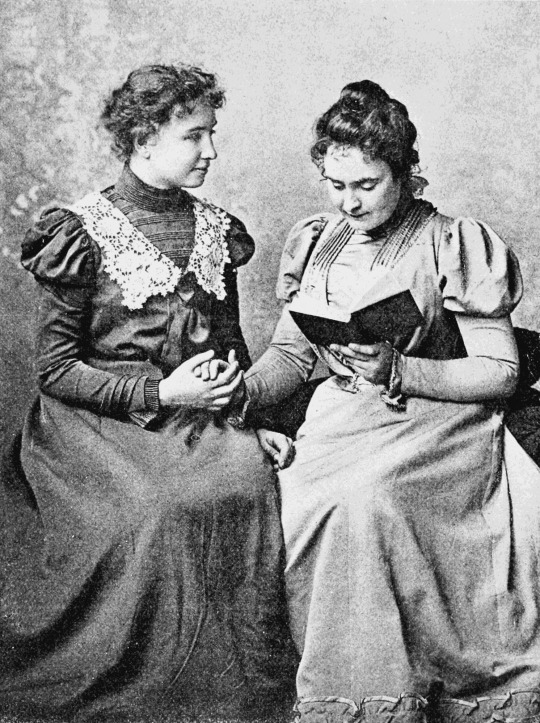
Helen Keller in 1899 with lifelong companion and teacher Anne Sullivan. Photo taken by Alexander Graham Bell at his School of Vocal Physiology and Mechanics of Speech.
Her unprecedented accomplishments in overcoming her disabilities made her a celebrity at an early age; at twelve she published an autobiographical sketch in the Youth’s Companion, and during her junior year at Radcliffe, she produced her first book, The Story of My Life, still in print in over fifty languages.
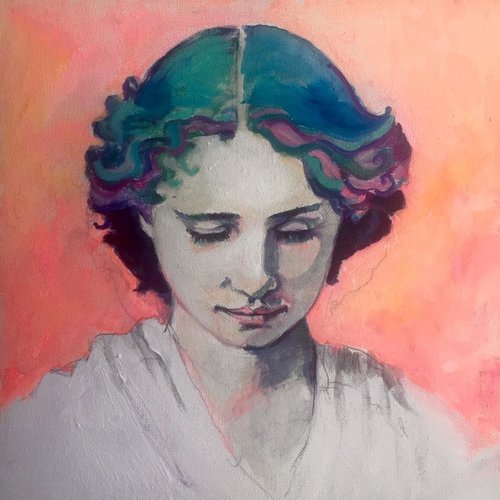
Helen Keller — Groundbreaking Girls
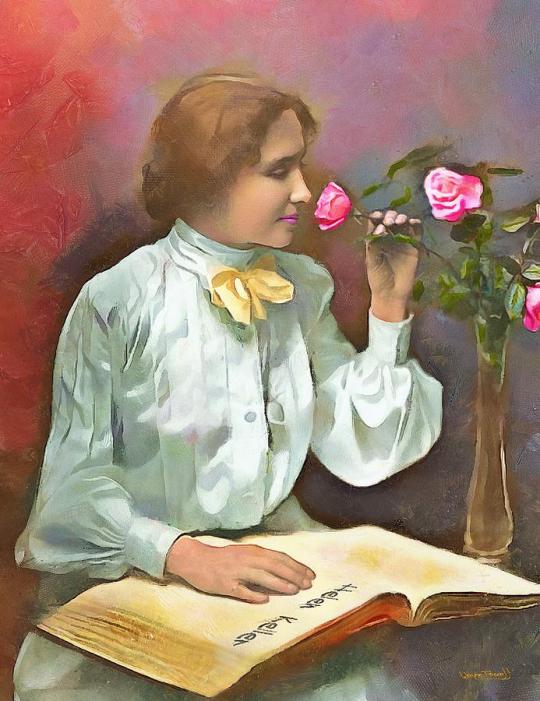
Painting of Keller's colorized portrait by Wayne Pascall
Her friendship with Mark Twain
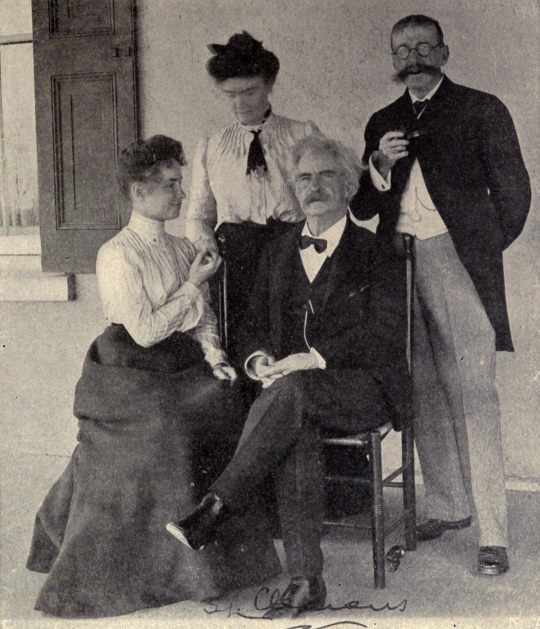
"Helen Keller, Miss Sullivan, Mark Twain and Laurence Hutton."
“From that day until his death we were friends,” Keller recalled later. She was already a fan of his work and thrilled to his deep voice and his many hand gestures, which she followed with her own fingertips. She wrote of him:
"He entered into my limited world with enthusiasm just as he might have explored Mars. Blindness was an adventure that kindled his curiosity. He treated me not as a freak, but as a handicapped woman seeking a way to circumvent extraordinary difficulties. There was something of divine apprehension in this rare naturalness towards those who differ from others in external circumstances."

Helen Keller with Mark Twain - Twain came to Keller’s defense, after reading in her book about a plagiarism scandal that occurred in 1892 when, at only twelve years old, she was accused of lifting her short story “The Frost King” from Margaret Canby’s “Frost Fairies.” Though a tribunal acquitted Keller of the charges, the incident still pissed off Twain. The letter is attached to the photo above
Letters between Mark Twain and Helen Keller.
Though Helen hailed from a respectable Southern family, 19th-century America was flummoxed by the prospect of teaching a deaf-blind girl to talk, read, and learn. Helen’s tutor and governess, Annie Sullivan, fought for her admission to various schools that offered special education. But the cost of educating someone like Helen was high. Clemens wrote to a rich friend on her behalf:
"It won’t do for America to allow this marvelous child to retire from her studies because of poverty. If she can go on with them she will make a fame that will endure in history for centuries. Along her special illness she is the most extraordinary product of all the ages…lay siege to your husband & get him to interest himself and Messrs. John D. & William Rockefeller & the other Standard Oil chiefs in Helen’s case; get them to subscribe an annual aggregate of six or seven hundred or a thousand dollars- & agree to continue this for three or four years, until she has completed her college course…."
Thanks to his intervention, the support of his friend Henry Rogers and Standard Oil, Helen was able to complete her education and graduate cum laude from Harvard’s Radcliffe College. Clemens and Keller remained friends for the rest of his life. They shared an interest in radical politics and a love for life despite their different temperaments. Helen, an avowed optimist, often made fun of Clemens for his avowed pessimism, telling him she didn’t believe a word of his sardonic jokes. As for Clemens, Chambliss writes that he felt she was one of the most important historical figures of all time, “the most wondrous person of her sex that has existed on this earth since Joan of Arc.”
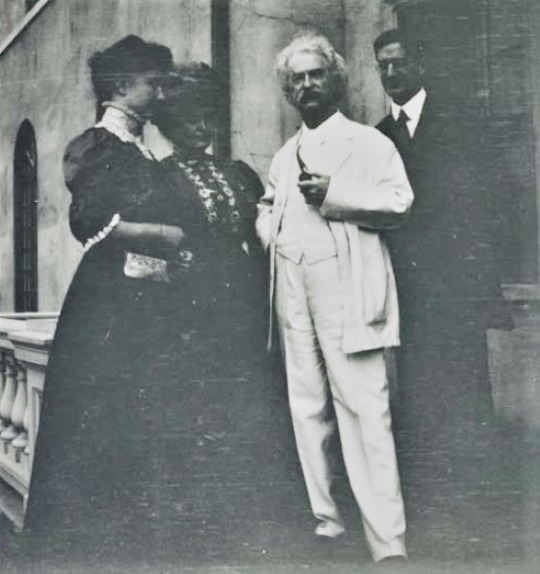
Keller, Sullivan, Twain, & Sullivan’s husband John Macy above at Twain’s home
We also have Twain—not playwright William Gibson—to thank for the “miracle worker” title given to Keller’s teacher, Anne Sullivan. As a tribute to Sullivan for her tireless work with Keller, he presented her with a postcard that read, “To Mrs. John Sullivan Macy with warm regard & with limitless admiration of the wonders she has performed as a ‘miracle-worker.’” In his 1903 letter to Keller, he called Sullivan “your other half… for it took the pair of you to make complete and perfect whole.”
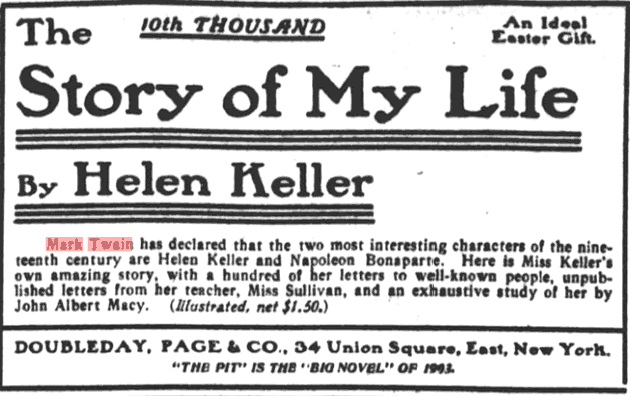
Twain was especially impressed by Keller’s autobiography, writing to her, “I am charmed with your book—enchanted.” (See his endorsement in a 1903 advertisement, above.)
Keller & Clemens also shared a love of dogs
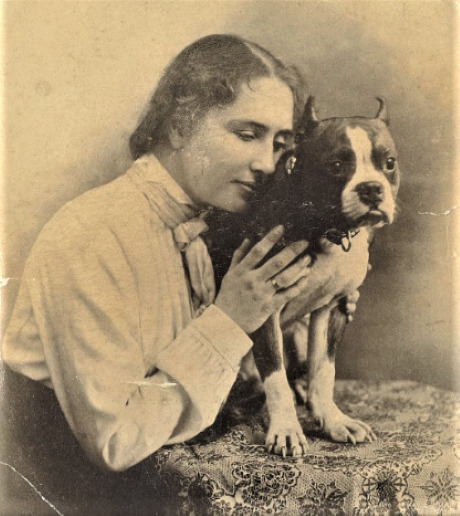
Helen Keller with her dog Sir Thomas.
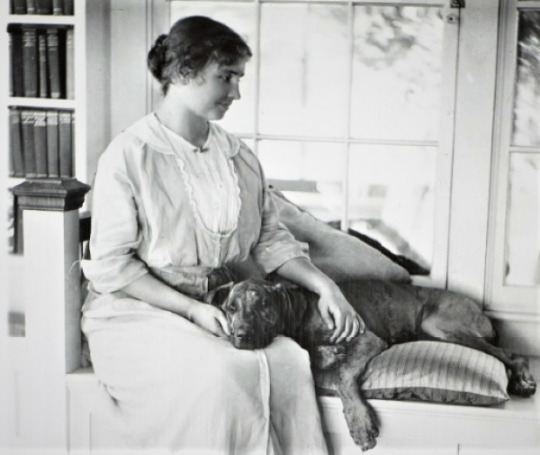
Helen Keller seated on a window bench with an arm around her dog Sieglinde.
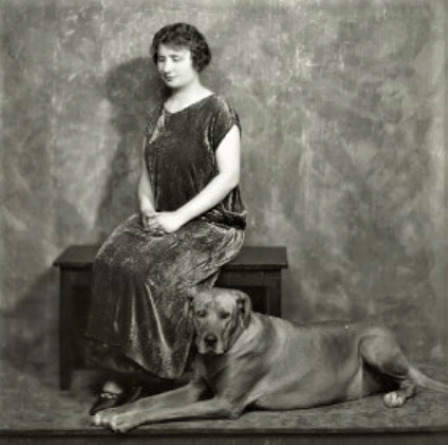
Helen Keller seated on a bench indoors, possibly in the photographer's studio wth a dog seated on the ground beside her.
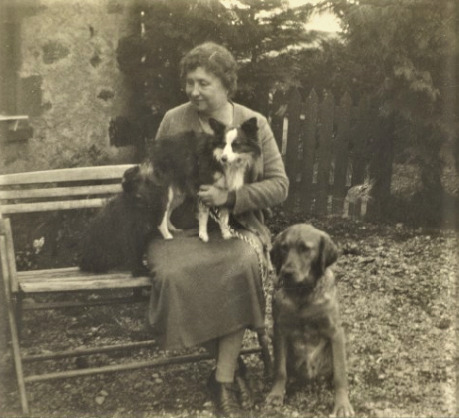
Helen Keller seated on a slatted bench in front of a Farm House in 1935 with her dogs Dileas, on her lap, Maida beside her & Golden.

Helen Keller teaching a girl sign language.
Widely honored throughout the world and invited to the White House by every U.S. president from Grover Cleveland to Lyndon B. Johnson, Keller altered the world’s perception of the capacities of the handicapped. More than any act in her long life, her courage, intelligence, and dedication combined to make her a symbol of the triumph of the human spirit over adversity.

Helen Keller - 1880-1968
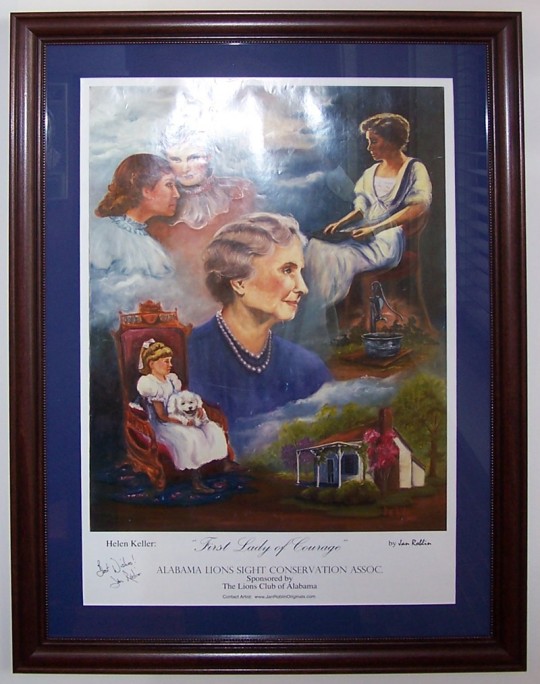
Helen Keller Archive
#helen keller#samuel clemens#mark twain#anne sullivan#anne sullivan macy#john macy#Henry Rogers#blind#sign language#braille#miracle worker#Alexander Graham Bell#Radcliffe College#suffragette#women's suffrage#suffrage#deaf#handicapped#cliff clavin#art
108 notes
·
View notes
Text
Literature produced in the ex-colonial countries but produced directly in languages which had been imported initially from Europe provides one kind of archive for the metropolitan university to construe the textual formation of ‘Third World Literature’; but this is not the only archive available, for the period after decolonization has also witnessed great expansion and consolidation of literary traditions in a number of indigenous languages as well [...] Not much of this kind of literature is directly available to the metropolitan literary theorists because, erudite as they usually are in metropolitan languages, hardly any of them has ever bothered with an Asian or African language. But parts and shades of these literatures also become available in the West, essentially in the following three ways. By far the greater part of the archive through which knowledge about the so-called Third World is generated in the metropolises has traditionally been, and continues to be, assembled within the metropolitan institutions of research and explication, which are characteristically administered and occupied by overwhelmingly Western personnel. Non-Western individuals have also been employed in these same institutions – more and more so during the more recent, post-colonial period, although still almost always in subordinate positions. The archive itself is dispersed through myriad academic disciplines and genres of writing – from philological reconstruction of the classics to lowbrow reports by missionaries and administrators; from Area Study Programmes and even the central fields of the Humanities to translation projects sponsored by Foundations and private publishing houses alike – generating all kinds of classificatory practices. A particularly large mechanism in the assembly of this archive has been the institutionalized symbiosis between the Western scholar and the local informant, which is frequently re-enacted now – no doubt in far more subtle ways –between the contemporary literary theorist of the West, who typically does not know a non-Western language, and the indigenous translator or essayist, who typically knows one or two. This older, multidisciplinary and somewhat chaotic archive is greatly expanded in our own time, especially in the area of literary studies, by a developing machinery of specifically literary translations – a machinery not nearly as highly developed as the one that exists for the circulation of texts among the metropolitan countries themselves, but not inconsiderable on its own terms. Apart from the private publishing houses and the university presses which may publish such translations of their own volition or under sponsorship programmes, there are state institutions such as the Sahitya Akademi in India, as well as international agencies such as UNESCO, not to speak of the American ‘philanthropic’foundations such as the Rockefeller-funded Asia Society, which have extensive programmes for such publications. Supplementing these translations are the critical essay and its associated genres, usually produced by an indigenous intellectual who reads the indigenous language but writes in one of the metropolitan ones. Some of this kind of writing becomes available in the metropolises, creating versions and shadows of texts produced in other spaces of the globe, but texts which frequently come with the authority of the indigenous informant.
Aijaz Ahmed, In Theory: Nations, Classes, Literatures
170 notes
·
View notes
Note
america invented eugenics?
the USA specifically did. we used it most acutely against immigrants, against institutionalized people, the mentally ill, the disabled, and anyone who wasn’t white. and it very much inspired the nazi party. eugenics is deeply and quietly entrenched in our history. do you know of Hellen Keller? she believed in eugenics. yea seriously
A lot of early thinkers and progressives were eugenicists too.
The American eugenics movement received extensive funding from various corporate foundations including the Carnegie Institution, Rockefeller Foundation, and the Harriman railroad fortune. In 1906, J.H. Kellogg provided funding to help found the Race Betterment Foundation in Battle Creek, Michigan.[13] The Eugenics Record Office (ERO) was founded in Cold Spring Harbor, New York in 1911 by the renowned biologist Charles B. Davenport, using money from both the Harriman railroad fortune and the Carnegie Institution. As late as the 1920s, the ERO was one of the leading organizations in the American eugenics movement.
In years to come, the ERO and the American Eugenics Society collected a mass of family pedigrees and provided training for eugenics field workers who were sent to analyze individuals at various institutions, such as mental hospitals and orphanage institutions, across the United States. Eugenicists such as Davenport, the psychologist Henry H. Goddard, Harry H. Laughlin, and the conservationist Madison Grant (all of whom were well-respected during their time) began to lobby for various solutions to the problem of the "unfit."
Davenport favored immigration restriction and sterilization as primary methods; Goddard favored segregation in his The Kallikak Family; Grant favored all of the above and more, even entertaining the idea of extermination.
Here’s the Wikipedia about the subject if you want to keep reading about it
TW for forced sterilization, eugenics (obviously), genocide, abuse.
#I’m#not a historian or academic I’m just some guy don’t quote me#eugenics#american eugenics#racism#xenophobia
107 notes
·
View notes
Photo

New York City
New York tumblr more photos here
New York City, often simply referred to as NYC, is one of the most iconic and vibrant cities in the world. Located in the northeastern part of the United States, it is situated on the southeastern tip of the state of New York. With a population of over 8 million residents within the city limits and over 20 million in the greater metropolitan area, it is the most populous city in the United States.
Geography and Layout: New York City is composed of five boroughs: Manhattan, Brooklyn, Queens, The Bronx, and Staten Island. The city is located on a series of islands and connected by bridges and tunnels. Manhattan, the heart of the city, is where many of its most famous landmarks are located. It is divided into several neighborhoods, each with its own distinct character and atmosphere. The city is known for its impressive skyline, dominated by iconic skyscrapers like the Empire State Building, One World Trade Center (Freedom Tower), and the Chrysler Building.
Culture and Diversity: One of New York City's defining characteristics is its incredible diversity. People from all over the world have made the city their home, resulting in a rich tapestry of cultures, languages, cuisines, and traditions. This diversity is celebrated through various cultural events, festivals, and neighborhoods that showcase the heritage of different communities.
The city's cultural scene is unparalleled, with world-class museums such as the Metropolitan Museum of Art, the Museum of Modern Art (MoMA), and the American Museum of Natural History. Broadway, located in the Theater District of Manhattan, is synonymous with American theater and is famous for its top-tier productions.
Economy and Business: New York City is a global economic powerhouse. Its financial district, centered around Wall Street in Lower Manhattan, is home to some of the world's largest and most influential financial institutions. The city's economy is incredibly diverse, encompassing finance, media, technology, fashion, tourism, and more.
Education and Research: The city boasts some of the world's most prestigious universities, including Columbia University, New York University (NYU), and The City University of New York (CUNY) system. These institutions contribute to the city's reputation as a hub for research, innovation, and intellectual exchange.
Cuisine and Culinary Scene: New York City is a culinary melting pot, offering an array of dining options that reflect its multicultural makeup. From street food carts offering hot dogs and pretzels to high-end restaurants serving international cuisines, the city caters to all tastes and budgets. Iconic foods like New York-style pizza, bagels, and deli sandwiches are part of the city's culinary fabric.
Transportation: The city's extensive public transportation system, which includes the subway, buses, and ferries, is a crucial part of daily life for millions of residents and visitors. The yellow taxi cabs are also an iconic symbol of the city's transportation.
Landmarks and Attractions: New York City is home to an impressive array of landmarks and attractions. Some of the must-visit places include:
Times Square: A bustling commercial and entertainment hub known for its bright lights, theaters, and New Year's Eve celebrations.
Central Park: An expansive green oasis in the heart of Manhattan, offering a retreat from the urban hustle and bustle.
Statue of Liberty and Ellis Island: Iconic symbols of American freedom and immigration history.
Brooklyn Bridge: A historic suspension bridge connecting Manhattan and Brooklyn, offering stunning views of the city skyline.
Rockefeller Center: A complex of commercial buildings, famous for its ice-skating rink and the Top of the Rock observation deck.
The High Line: A unique elevated park built on a former railway track, offering a serene escape above the city streets.
Museums and Art Galleries: In addition to the aforementioned museums, NYC is home to the Guggenheim Museum, Whitney Museum of American Art, and more.
Challenges and Opportunities: Despite its allure, New York City also faces challenges such as high living costs, traffic congestion, and issues related to affordable housing. The city has shown resilience in the face of challenges, and initiatives are continually being developed to address these concerns and create a more equitable and sustainable future.
In summary, New York City is a dynamic and multifaceted metropolis that captivates visitors and residents alike with its cultural richness, economic vitality, and unparalleled energy. Its ability to constantly reinvent itself while honoring its history makes it a truly remarkable and enduring global city.
#New York City#new york#newyork#New-York#nyc#NY#Manhattan#urban#city#USA#United States#buildings#travel#journey#outdoors#street#architecture#visit-new-york.tumblr.com
148 notes
·
View notes
Text
Oppressed people are more than capable of acting against their own groups. Phyllis Schlafly is right up there with Malala Yousafzai and Angela Davis as one of the most influential “women’s rights” activists to ever live. The only problem? She almost single-handedly killed a proposed Amendment to the Constitution that said, “Equality of rights under the law shall not be denied or abridged by the United States or by any state on account of sex.” Due to the actions of a cis woman, there is no Constitutional protection for the rights of people assigned female at birth. In Schlafly’s mind, there is no contradiction between fighting for women’s rights and striking down the Equal Rights Amendment. “What I am defending is the real rights of women,” she explained. “A woman should have the right to be in the home as a wife and mother.” She leveraged her gender identity to maintain institutional misogyny. Schlafly behaved as if she spoke for all women, when in fact she was only one among billions.
In truth, no one can speak for all women. As Kimberly Probolus wrote in her New York Times Op Ed Men, You Need to Listen to Women, “...active listening means hearing the words women are saying and taking them at face value, even if those words contradict your prior assumptions or your own agenda.” But Probolus adds an important qualification: “Women do not speak with one voice. We don’t all want the same things…” Without that qualification, active listening easily becomes regressive nonsense. It would be nothing more than blind obedience to self-appointed oligarchs like Schlafly. “The analysis that all women are allies and that all men are enemies was in error,” wrote the feminist communist Leslie Feinberg. “It puts Sojourner Truth and Margaret Thatcher on one side and John Brown and John Rockefeller on the other.” There are gay homophobes, Jewish anti-semites, and Black anti-Black racists.
If Attack Helicopter really had been written by a cis person, that would not make it transphobic. And if Attack Helicopter really had been transphobic, that would have been a moral problem with the message of the text—even if the transphobic author were a transgender person. All of us have the potential to do wrong. Hiding behind identity labels will not resolve you of moral culpability, and it will not help you do the right thing.
You can read the rest on Substack
41 notes
·
View notes
Text
In fact, despite the Rockefeller Institute's best efforts to massage its public image,⁴⁵ Carrel appears to have behaved just like the antivivisectionists' stereotype of the unfeeling experimental physiologist.
45 At one stage, Flexner, the Institute director, announced the appointment of a special assistant to take care of Carrel's dogs. See Corner, 1964, pp. 85-7.
"Frankenstein's Footsteps: Science, Genetics and Popular Culture" - Jon Turney
#book quote#frankenstein's footsteps#jon turney#nonfiction#rockefeller institute#public image#alexis carrel#vivisection#unfeeling#experimental#physiology#simon flexner
0 notes
Text
One of the most diabolical stories of our time is the birth of Big Pharma. Its “rich history” of corruption began with John D. Rockefeller, oil magnate and the man responsible for our transition from time-honored herbal medicine to petroleum-based “medicine.” This unholy union of oil and drugs has continued to erode our society, government and health for decades.
People are waking up to the dark intentions of our institutions and leaders. With minor repercussions at most, many in power are more than willing to trade OUR health for dollars. The last few years in particular are showing… the emperor wears no clothes anymore, the naked truth is out. 🤔
#pay attention#educate yourself#educate yourselves#knowledge is power#reeducate yourself#reeducate yourselves#think for yourself#think for yourselves#think about it#big pharma#drugs
157 notes
·
View notes
Note
A Peter Parker in Gotham fic but from the perspective of a Tony Stark who came back to life after the events of No Way Home and sets out on a quest to find his missing child
(Sorry @theneonghosts that it has taken me so long to respond to this ask) I hope you like my response, though I'm not sure if that's what you were looking for. I've never really written anything like this before for a Tumblr post.
Tony gasped awake, his heartbeat racing as he returned to consciousness. He was lying prone on hard concrete slab in what appeared to be a morgue. His right arm ached, muscle pain like he hadn't experienced in years. Looking down at it, he could see it had old, healed over, burn scars covering it. Tracing them, he could feel them go all the way up his neck, just touching the underside of his jaw.
He stumbled to his feet, off the the slab and onto the cold floor. His feet were bear, and protested being pressed against the frigid tiles. Looking around, he saw some clean scrubs on a shelf, and quickly dressed. He had to figure out where he was, and how he'd got there.
The last thing he remembered was Pepper and Peter talking to him after he used the Infinity Stones to destroy Thanos and his army. And then... nothing. The next thing he knew, he was waking up here.
He walked over to the computer in the corner of the room, used for medical files and such, and easy cracked into it. The date... It had been a year since that last battle. Had he been in a coma? Had he just died, only to wake up in a morgue? Searching more, he found that no, he had died that day. There had been a funeral and everything, where he was buried. He had a gravestone. So how had he woken up here if he was supposed to be six feet under?
Tony quickly searched for Pepper and Morgan, the former who had taken up the post of CEO of Stark Industries. However, there was no mention of Peter.
None.
His frown deepened, and he began searching for Peter more in depth.
Apparently, Spider-Man had disappeared from New York a month ago, and the city had been left without their friendly neighbourhood superhero. Peter's friends were at MIT, but Peter... Peter was not. There was no history of an application, not history period. May Parker was dead, with no mention of a nephew, no other family.
There were no school records for Peter Parker at Midtown School of Technology. No records of him anywhere.
What the actual fuck was going on here?
There was actually an internal phone attached to the wall, usually only used to contact other departments within a hospital. But, it should still be able to make outside calls.
He dialled Peter's phone number.
"I'm sorry, the phone number you are calling has been disconnected-"
Tony's chest felt tight. He redialled.
"I'm sorry, the phone number you are calling has been disconnected-"
He swallowed harshly. He had to get to the bottom of this. He called Pepper's phone.
"Hello? This is Virginia Stark."
"Pepper. No, please, don't hang up. This isn't a prank, I swear. I don't know where I am. Other than in a fucking morgue. Last thing I remember was you and Peter saying good bye to me after I used the Infinity Stones. Uh, you're allergic to strawberries. I love you 3000. I don't know how to prove it any other wa-"
"Shut up. Just shut up Tony. I get it. You're you. Stranger and more fucked up things have happened. We'll get explanations later. Caller ID says you're calling from the Rockefeller Institute Hospital. And who the hell is Peter?"
Something was very, very wrong here.
#definitely-not-indecisive#theneonghosts#asks#fic ask#my writing#my work#marvel au fic#Peter Parker in Gotham au#Tony Stark comes back au
30 notes
·
View notes
Text

Patti Smith arrived in New York on July 3, 1967, via the decidedly un-scenic Port Authority Bus Terminal (625 8th Ave.), where she immediately transferred to the subway and headed for Brooklyn. She hoped to connect with a friend who was enrolled at the nearby Pratt Institute, an Engineering and Arts college in Clinton Hill. Unfortunately, it was summer break and her friend had moved to a new apartment. One of the current residents knew where her friend could be found, though, and offered to direct her there. This would be her first fleeting encounter with Robert Mapplethorpe, a young Pratt art student, and the man who would ultimately become her closest companion for the next few years. Alas, her friend was not at the said address, so Patti would sleep rough for the next several days, on porches, and in Central Park close to the statue of Alice in Wonderland.
Like many young newcomers, she would wander the streets of Greenwich Village and spend hours observing the people in Washington Square Park, an active gathering place for artists, folkies, activists, and people of every stripe imaginable. She explored St. Marks Place and the East Village, then a fairly ragged but colorful neighborhood of immigrants, hippies, artists, and the poor, always dragging her plaid suitcase along with her. One day she and a street friend found a little money and treated themselves to a hot meal at the Waverly Diner (385 6th Ave.), but otherwise she ate day-old bread and handouts. The rest of the time she was desperately looking for work, and after a disastrous single shift waiting tables at a Times Square restaurant, she found work at the midtown flagship location of Brentano’s (586 5th Ave.), a venerable bookstore near Rockefeller Center. She still had no place to stay, though, and often surreptitiously slept in the store overnight, only to emerge from the bathroom in the morning as the others readied the store. One day she ran into Mapplethorpe again in the bookstore. He, coincidentally, worked at the downtown branch of Brentano’s (20 University Pl.) in the Village. Not long afterwards, in the midst of an uncomfortable date with an older bookstore patron, Patti spotted Mapplethorpe in Tompkins Square Park, where he happily rescued her by posing as her boyfriend. The two shared an egg cream at Gem Spa (131 2nd Ave.) while commiserating. The pair would become inseparable. He brought her to stay at his place, an attic room in the home of some friends on Waverly Avenue in Brooklyn. After several weeks, the two had enough money saved for their own place nearby at 160 Hall St. on the second floor for $80 per month. This would become their headquarters for well over a year.
By winter, both Patti and Robert had lost their jobs at Brentano’s but found seasonal employment at FAO Schwarz (745 5th Ave.), the gigantic toy shop. Robert decorated windows, but Patti was stuck at the cash register. Afterward, she worked briefly at Argosy Books (116 E. 59th St.) before settling at Scribner’s Book Store (597 5th Ave.). Scribner’s would be her steady job for the next couple of years. Robert, meanwhile, went through a succession of jobs, one of which was as an usher at the Fillmore East (105 2nd Ave.), where he was able to get Patti in to see the Doors. Jim Morrison was to have a lasting influence on her...
-- Excerpt from the Rock and Roll Explorer Guide to New York City (Globe Pequot Press, June 2018) by Mike Katz and Crispin Kott, with a foreword by Legs McNeil. Also available by the same authors: Rock and Roll Explorer Guide to San Francisco and the Bay Area (Globe Pequot Press, May 2021), with a foreword by Joel Gion of the Brian Jonestown Massacre. Get ‘em both wherever books are sold at maximum volume.
Patti Smith & Robert Mapplethorpe by Norman Seeff,
77 notes
·
View notes
Text
Talking about vaccines…
The ‘Spanish Flu’ of 1918, did not actually originate in Spain. Spain was simply the first country to report on it.
In preparation for WW1, a massive military vaccination experiment involving numerous prior developed vaccines took place in Fort Riley, Kansas- where the first “Spanish Flu” case was reported.
The fledgling pharmaceutical industry, sponsored by the ‘Rockefeller Institute for Medical Research’, had something they never had before – a large supply of human test subjects. Supplied by the U.S. military’s first draft, the test pool of subjects ballooned to over 6 million men.
Autopsies after the war proved that the 1918 flu was NOT a ‘flu’ at all. It was caused by random dosages of an experimental ‘bacterial meningitis vaccine’, which to this day, mimics flu-like symptoms.
Fearing that soldiers coming home would spread diseases to their families, the U.S. government pushed the largest vaccine ‘fear’ campaign in history. They used the human population as a research and development lab to field test experimental vaccines.
Tens of millions of civilians died in the same manner as did the soldiers.
Instead of stopping the vaccines, doctors intensified them, calling it the great “Spanish Flu of 1918”. As a result, ONLY THE VACCINATED DIED.
https://t.me/LauraAbolichannel
41 notes
·
View notes